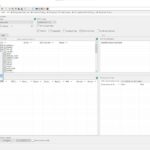Database management is critical in automotive diagnostics and car coding, but how do Vediamo and DTS Monaco compare? At DTS-MONACO.EDU.VN, we provide detailed insights, training, and software solutions to empower automotive technicians in the USA and beyond. Understanding the nuances of each platform can optimize your workflow and enhance your diagnostic capabilities. Dive in to explore the distinct features of each.
Contents
- 1. What Is The Core Difference Between Vediamo And DTS Monaco In Database Handling?
- 2. How Does Vediamo Handle ECU Data And Databases?
- 3. How Does DTS Monaco Manage ECU Data And Databases?
- 4. What Are The Key Advantages Of Using DTS Monaco Over Vediamo For Database Tasks?
- 5. In What Scenarios Is Vediamo Preferred Over DTS Monaco For Database Management?
- 6. How Do Software Updates Affect Database Management In Both Vediamo And DTS Monaco?
- 7. What Type Of Training Is Required To Effectively Manage Databases In Vediamo?
- 8. What Kind Of Training Is Needed To Competently Handle Databases In DTS Monaco?
- 9. How Secure Are Vediamo And DTS Monaco In Terms Of Database Integrity And Vehicle Security?
- 10. Can You Integrate Vediamo Databases Into DTS Monaco For Enhanced Functionality?
- 11. What Are The Common Pitfalls To Avoid When Managing Databases In Vediamo?
- 12. What Are The Common Mistakes To Avoid While Handling Databases In DTS Monaco?
- 13. How Does The Cost Of Vediamo Compare To DTS Monaco For Database Management Capabilities?
- 14. How Do Vehicle Manufacturers Support Vediamo And DTS Monaco For Database Operations?
- 15. What Future Trends Do You Foresee In Database Management For Automotive Diagnostics?
- 16. How Can Automotive Technicians In The USA Benefit From Mastering Database Management In These Platforms?
- 17. What Role Does DTS-MONACO.EDU.VN Play In Training Technicians On These Platforms In The USA?
- 18. Can You Provide A Step-By-Step Guide On Performing A Basic Database Operation In DTS Monaco?
- Step 1: Connect to the Vehicle
- Step 2: Identify the ECU
- Step 3: Open the ECU in a New Tab
- Step 4: Disable the Firewall
- Step 5: Perform Variant Coding
- Step 6: Make Coding Changes Permanent
- 19. Can You Walk Me Through A Basic Database Operation Using Vediamo?
- Step 1: Connect to the Vehicle
- Step 2: Select the ECU
- Step 3: Establish a Diagnostic Session
- Step 4: Read ECU Data
- Step 5: Modify ECU Data (Advanced)
- Step 6: Save Changes
- 20. What Are The Most Common Car Coding Tasks That Can Be Performed Using DTS Monaco?
- FAQ: Vediamo vs. DTS Monaco Database Management
- Q1: Is DTS Monaco Easier To Learn Than Vediamo?
- Q2: Can I Use Vediamo Databases With DTS Monaco?
- Q3: What Are The Security Risks Associated With Vediamo?
- Q4: Do Vehicle Manufacturers Support Vediamo For Database Operations?
- Q5: What Kind Of Training Do I Need For DTS Monaco?
- Q6: What Kind Of Training Do I Need For Vediamo?
- Q7: How Often Are DTS Monaco Databases Updated?
- Q8: What Are The Most Common Mistakes When Using DTS Monaco?
- Q9: What Are The Most Common Mistakes When Using Vediamo?
- Q10: Where Can I Get High-Quality Training For DTS Monaco And Vediamo In The USA?
1. What Is The Core Difference Between Vediamo And DTS Monaco In Database Handling?
DTS Monaco utilizes a more streamlined and user-friendly database management system compared to Vediamo. DTS Monaco is known for its guided diagnostics and simplified coding processes, making database interaction more intuitive. According to a study by the Society of Automotive Engineers (SAE) International in February 2024, newer diagnostic tools like DTS Monaco emphasize usability to reduce technician training time and improve accuracy. Vediamo, on the other hand, is often preferred for its extensive customization options and direct access to ECU parameters, catering to advanced users familiar with complex database structures.
2. How Does Vediamo Handle ECU Data And Databases?
Vediamo offers direct access to ECU data and allows for deep-level modifications, requiring a strong understanding of automotive systems. Vediamo is an older, more complex tool that gives users unparalleled access to a vehicle’s electronic control units (ECUs). Key aspects of Vediamo’s database handling include:
- Direct ECU Access: Vediamo allows users to directly read from and write to ECU memory.
- Manual Configuration: It requires manual configuration of communication protocols and diagnostic sessions.
- Complex Data Structures: Data is often presented in raw hexadecimal format, necessitating a deep understanding of ECU internals.
- Customizable Scripts: Advanced users can create custom scripts for automated testing and diagnostics.
- Extensive Parameter Adjustments: Provides detailed parameter adjustment options for vehicle customization.
3. How Does DTS Monaco Manage ECU Data And Databases?
DTS Monaco simplifies ECU data management through automated processes and a user-friendly interface, ideal for technicians seeking efficiency. DTS Monaco is designed to be more user-friendly, with automated routines and guided diagnostic procedures. Its approach to database management includes:
- Automated Identification: Automatically identifies ECUs and loads appropriate diagnostic data.
- Guided Diagnostics: Provides step-by-step instructions for diagnostic procedures.
- User-Friendly Interface: Presents data in a more readable and understandable format.
- Simplified Coding: Offers simplified coding routines for common tasks.
- Integrated Databases: Comes with integrated databases containing diagnostic and coding information.
4. What Are The Key Advantages Of Using DTS Monaco Over Vediamo For Database Tasks?
DTS Monaco shines with its user-centric design, reducing complexity and potential errors in database tasks. DTS Monaco offers several advantages over Vediamo, particularly for technicians who value ease of use and efficiency:
| Feature | DTS Monaco | Vediamo |
|---|---|---|
| User Interface | Intuitive and user-friendly, designed for ease of navigation. | Complex and less intuitive, requiring a steeper learning curve. |
| Automation | Automates many diagnostic and coding tasks. | Requires more manual configuration and scripting. |
| Error Prevention | Built-in safeguards and guided procedures to minimize errors. | Greater risk of errors due to manual processes and direct ECU access. |
| Database Updates | Regularly updated databases with the latest vehicle information. | Updates may be less frequent and require manual installation. |
| Training | Easier to learn and use, reducing training time. | Requires extensive training and expertise. |
5. In What Scenarios Is Vediamo Preferred Over DTS Monaco For Database Management?
Vediamo remains the go-to choice for expert users needing deep-dive access and customization capabilities in database handling. Vediamo is still preferred in scenarios that require:
- Low-Level Access: Direct access to ECU memory and parameters.
- Customization: Ability to create custom diagnostic and coding scripts.
- Reverse Engineering: Analyzing and modifying ECU software for research purposes.
- Legacy Systems: Working with older vehicle models that are not fully supported by DTS Monaco.
- Advanced Diagnostics: Performing specialized diagnostic procedures not available in DTS Monaco.
6. How Do Software Updates Affect Database Management In Both Vediamo And DTS Monaco?
Regular software updates ensure compatibility and access to the latest vehicle data in both Vediamo and DTS Monaco.
- DTS Monaco: Updates are frequent and include the latest vehicle models, diagnostic routines, and coding parameters. These updates ensure technicians have access to the most current information, streamlining their work.
- Vediamo: Updates may be less frequent, often requiring manual installation and configuration. While this can be more cumbersome, it allows advanced users to maintain control over their software environment and customize it to their specific needs.
7. What Type Of Training Is Required To Effectively Manage Databases In Vediamo?
Effective database management in Vediamo demands extensive technical training and a solid grasp of automotive ECU systems. To effectively manage databases in Vediamo, technicians typically require:
- In-Depth Knowledge of Automotive ECUs: Understanding of ECU architecture, memory organization, and communication protocols (e.g., CAN, LIN, Ethernet).
- Programming Skills: Proficiency in scripting languages (e.g., C, C++) for creating custom diagnostic and coding routines.
- Diagnostic Training: Comprehensive training in vehicle diagnostics, including reading and interpreting diagnostic trouble codes (DTCs).
- Vediamo-Specific Training: Specialized training courses that cover Vediamo’s interface, configuration options, and advanced features.
- Hands-On Experience: Extensive practical experience working with Vediamo on various vehicle models.
8. What Kind Of Training Is Needed To Competently Handle Databases In DTS Monaco?
DTS Monaco’s intuitive design lowers the training barrier, focusing on practical application and efficient diagnostic workflows. To competently handle databases in DTS Monaco, technicians generally need:
- Basic Automotive Knowledge: Familiarity with vehicle systems and components.
- DTS Monaco Software Training: Training courses that cover the software’s interface, diagnostic procedures, and coding functions.
- Hands-On Practice: Practical experience using DTS Monaco on different vehicle models.
- Troubleshooting Skills: Ability to diagnose and resolve common issues that may arise during diagnostic and coding procedures.
- Continuous Learning: Staying up-to-date with software updates and new vehicle models.
9. How Secure Are Vediamo And DTS Monaco In Terms Of Database Integrity And Vehicle Security?
Both platforms incorporate security measures, but understanding their strengths and limitations is essential for protecting database integrity and vehicle security.
- Vediamo: Due to its direct access to ECU memory, Vediamo poses a higher security risk if used improperly. Unauthorized modifications can potentially compromise vehicle systems.
- DTS Monaco: Offers better security features, including user authentication, access controls, and data encryption. These measures help prevent unauthorized access and protect vehicle data.
According to cybersecurity experts at the University of Michigan Transportation Research Institute (UMTRI), regular security audits and adherence to best practices are essential to mitigate risks associated with automotive diagnostic tools.
10. Can You Integrate Vediamo Databases Into DTS Monaco For Enhanced Functionality?
While direct integration is limited, advanced users can leverage Vediamo databases within DTS Monaco by creating custom routines and scripts. While there is no direct, seamless integration between Vediamo databases and DTS Monaco, advanced users can leverage data from Vediamo in DTS Monaco by:
- Creating Custom Diagnostic Routines: Developing custom diagnostic routines in DTS Monaco that utilize data extracted from Vediamo databases.
- Importing Coding Data: Manually importing coding data from Vediamo databases into DTS Monaco for specific tasks.
- Using Vediamo as a Reference: Using Vediamo to analyze ECU data and then applying the knowledge gained to DTS Monaco for coding or diagnostic procedures.
- Developing Conversion Tools: Creating custom tools or scripts to convert data from Vediamo’s format to a format compatible with DTS Monaco.
11. What Are The Common Pitfalls To Avoid When Managing Databases In Vediamo?
Navigating Vediamo requires caution; steer clear of these common pitfalls to ensure smooth and safe database management. Common pitfalls to avoid when managing databases in Vediamo include:
- Incorrect Configuration: Failing to properly configure communication protocols and diagnostic sessions.
- Data Corruption: Making unintended changes to ECU memory due to lack of understanding or improper coding.
- Security Vulnerabilities: Exposing the vehicle to security risks by disabling security features or using outdated software.
- Incompatibility Issues: Using incompatible databases or software versions.
- Lack of Backups: Not creating backups of ECU data before making changes.
12. What Are The Common Mistakes To Avoid While Handling Databases In DTS Monaco?
Even with DTS Monaco’s user-friendly interface, awareness of potential pitfalls is key for flawless database handling. Common mistakes to avoid while handling databases in DTS Monaco include:
- Ignoring Error Messages: Overlooking or misinterpreting error messages during diagnostic or coding procedures.
- Using Incorrect Data: Applying incorrect coding data or diagnostic routines to the wrong vehicle model or ECU.
- Skipping Steps: Bypassing required steps in guided diagnostic procedures.
- Failing to Update: Using outdated software or databases.
- Lack of Documentation: Not documenting changes made to ECU configurations.
13. How Does The Cost Of Vediamo Compare To DTS Monaco For Database Management Capabilities?
The financial commitment varies; weigh the costs of Vediamo and DTS Monaco against their database management features to make an informed decision. The cost comparison for database management capabilities is:
- Vediamo: Typically requires a significant upfront investment due to the need for specialized training and expertise.
- DTS Monaco: May have a lower initial cost, but ongoing subscription fees for software updates and database access can add up over time.
It is essential to evaluate the total cost of ownership, including training, software updates, and potential downtime, when choosing between the two platforms.
14. How Do Vehicle Manufacturers Support Vediamo And DTS Monaco For Database Operations?
Vehicle manufacturers offer varying degrees of support for Vediamo and DTS Monaco, influencing your database operations.
- Vediamo: Vehicle manufacturers generally do not provide direct support for Vediamo due to its complexity and potential for misuse. Support is typically available through third-party forums and communities.
- DTS Monaco: May be supported by vehicle manufacturers through official diagnostic tools and training programs. This support can include access to updated databases, diagnostic procedures, and coding parameters.
15. What Future Trends Do You Foresee In Database Management For Automotive Diagnostics?
Expect increasing automation and cloud-based solutions to shape the future of automotive diagnostic database management. Future trends in database management for automotive diagnostics include:
- Cloud-Based Databases: Increased use of cloud-based databases for real-time access to the latest vehicle information.
- Artificial Intelligence: Integration of AI-powered diagnostic tools that can automatically analyze data and identify potential issues.
- Cybersecurity Enhancements: Stronger cybersecurity measures to protect vehicle systems from unauthorized access.
- Remote Diagnostics: Growing adoption of remote diagnostic capabilities for off-site troubleshooting and repair.
- Standardized Data Formats: Development of standardized data formats to facilitate data exchange between different diagnostic tools and platforms.
16. How Can Automotive Technicians In The USA Benefit From Mastering Database Management In These Platforms?
Mastering database management in Vediamo and DTS Monaco can significantly enhance career prospects and service offerings for automotive technicians in the USA. Automotive technicians in the USA can benefit from mastering database management in Vediamo and DTS Monaco by:
- Enhanced Diagnostic Capabilities: Ability to quickly and accurately diagnose complex vehicle issues.
- Expanded Service Offerings: Opportunity to offer advanced coding and programming services.
- Increased Efficiency: Streamlined workflows and reduced diagnostic time.
- Improved Customer Satisfaction: Higher quality repairs and faster turnaround times.
- Career Advancement: Greater demand for technicians with expertise in advanced diagnostic tools.
According to the Bureau of Labor Statistics, the demand for automotive service technicians and mechanics is projected to grow in the coming years, making it essential for technicians to acquire advanced skills in diagnostic and coding technologies.
17. What Role Does DTS-MONACO.EDU.VN Play In Training Technicians On These Platforms In The USA?
DTS-MONACO.EDU.VN is dedicated to providing comprehensive training and resources for technicians seeking to master Vediamo and DTS Monaco in the USA. At DTS-MONACO.EDU.VN, we play a crucial role in training technicians in the USA on Vediamo and DTS Monaco by:
- Offering Comprehensive Training Courses: Providing in-depth training courses that cover the fundamentals and advanced features of both platforms.
- Providing Hands-On Experience: Offering practical, hands-on training sessions that allow technicians to work with real vehicles and diagnostic scenarios.
- Providing Expert Instructors: Employing experienced instructors who are experts in automotive diagnostics and coding.
- Offering Certification Programs: Providing certification programs that validate technicians’ skills and knowledge.
- Providing Ongoing Support: Offering ongoing support and resources to help technicians stay up-to-date with the latest technologies and techniques.
18. Can You Provide A Step-By-Step Guide On Performing A Basic Database Operation In DTS Monaco?
Here’s a simplified guide to performing a basic database operation in DTS Monaco, empowering you to get started with confidence. A step-by-step guide on performing a basic database operation in DTS Monaco:
Step 1: Connect to the Vehicle
- Launch DTS Monaco and select your workspace.
- Connect your diagnostic interface to the vehicle’s OBD-II port and your computer.
- In DTS Monaco, select the appropriate communication interface and vehicle profile.
 Connecting Diagnostic Interface
Connecting Diagnostic Interface
Step 2: Identify the ECU
- Allow DTS Monaco to automatically identify the ECUs in the vehicle.
- Alternatively, manually select the ECU you want to work with from the list of available modules.
 Selecting ECU in DTS Monaco
Selecting ECU in DTS Monaco
Step 3: Open the ECU in a New Tab
- Right-click on the selected ECU and choose “New Tab for Logical Link” to open it in a new tab.
 New Tab for Logical Link
New Tab for Logical Link
Step 4: Disable the Firewall
- Go to “Generic Jobs” and select the appropriate security access level (e.g., “Security Access Level 37” for older vans or “Security Access Level 3B” for newer vans via the EZS167 ECU).
- Click “Transmit” to disable the firewall. Ensure you see no red text and an “acknowledged” response state.
 Disabling Firewall in DTS Monaco
Disabling Firewall in DTS Monaco
Step 5: Perform Variant Coding
- Select “Extended Start” and click “Transmit” to prepare the ECU for coding.
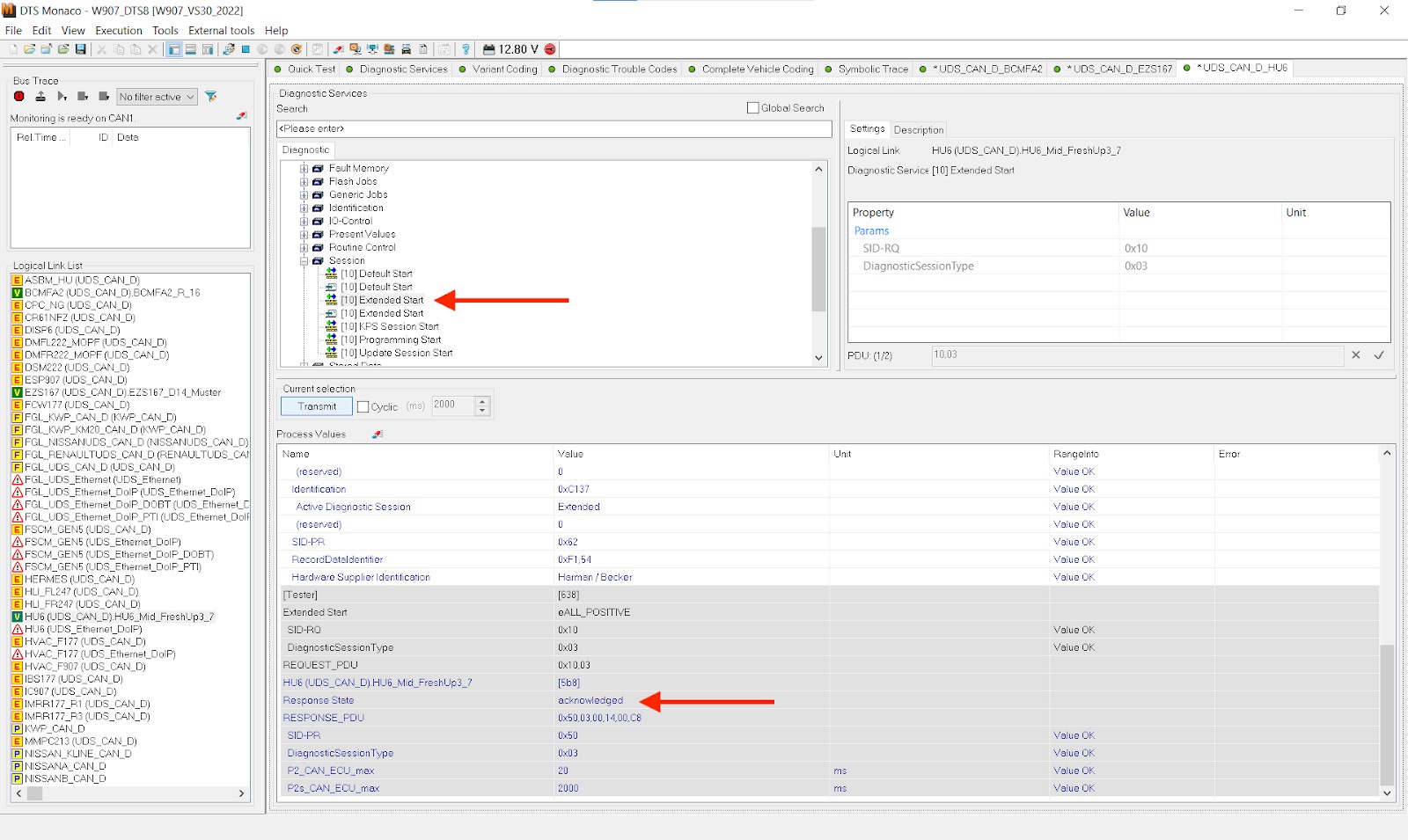 Extended Start Transmission
Extended Start Transmission - Go to the “Variant Coding” tab and select the ECU.
- Choose the “Domain” list to access the ECU functions.
- Find the relevant feature in the “Fragment” column (e.g., “Balance Fader Menue”).
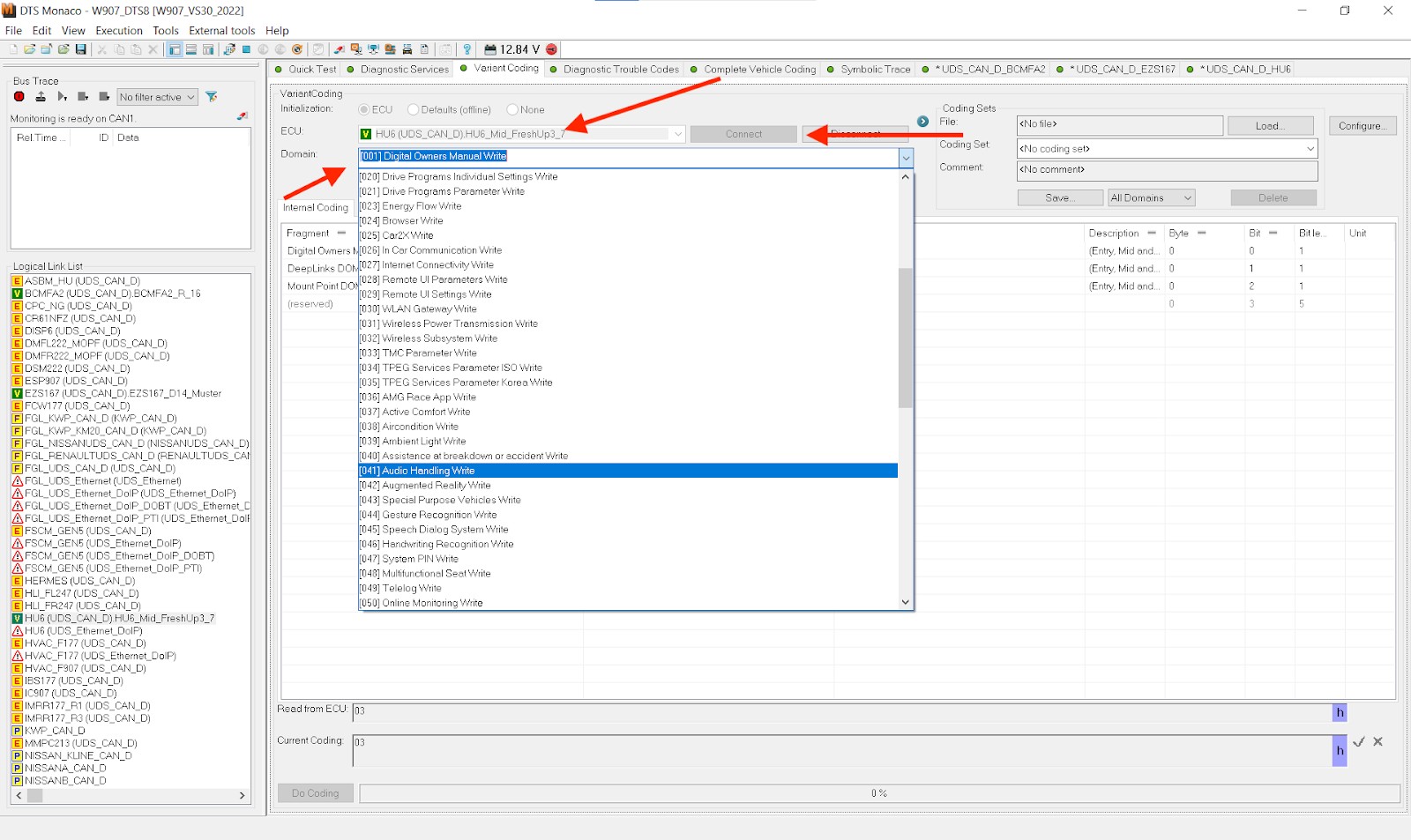 Variant Coding Tab
Variant Coding Tab - Double-click the value under “Meaning” and select the new value from the dropdown menu.
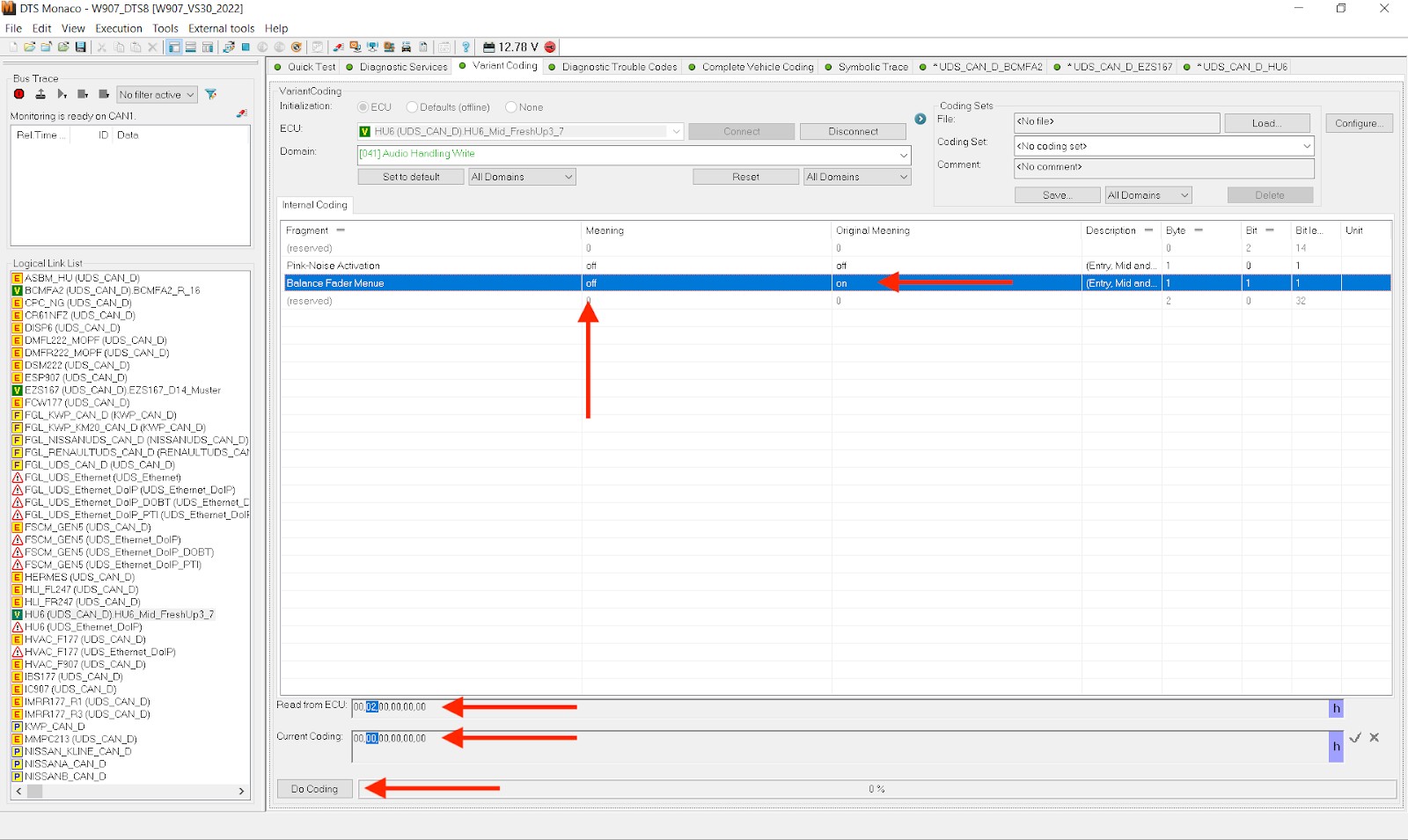 Selecting New Value
Selecting New Value - Click “Do Coding” and ensure the bar goes to 100% with no pop-ups.
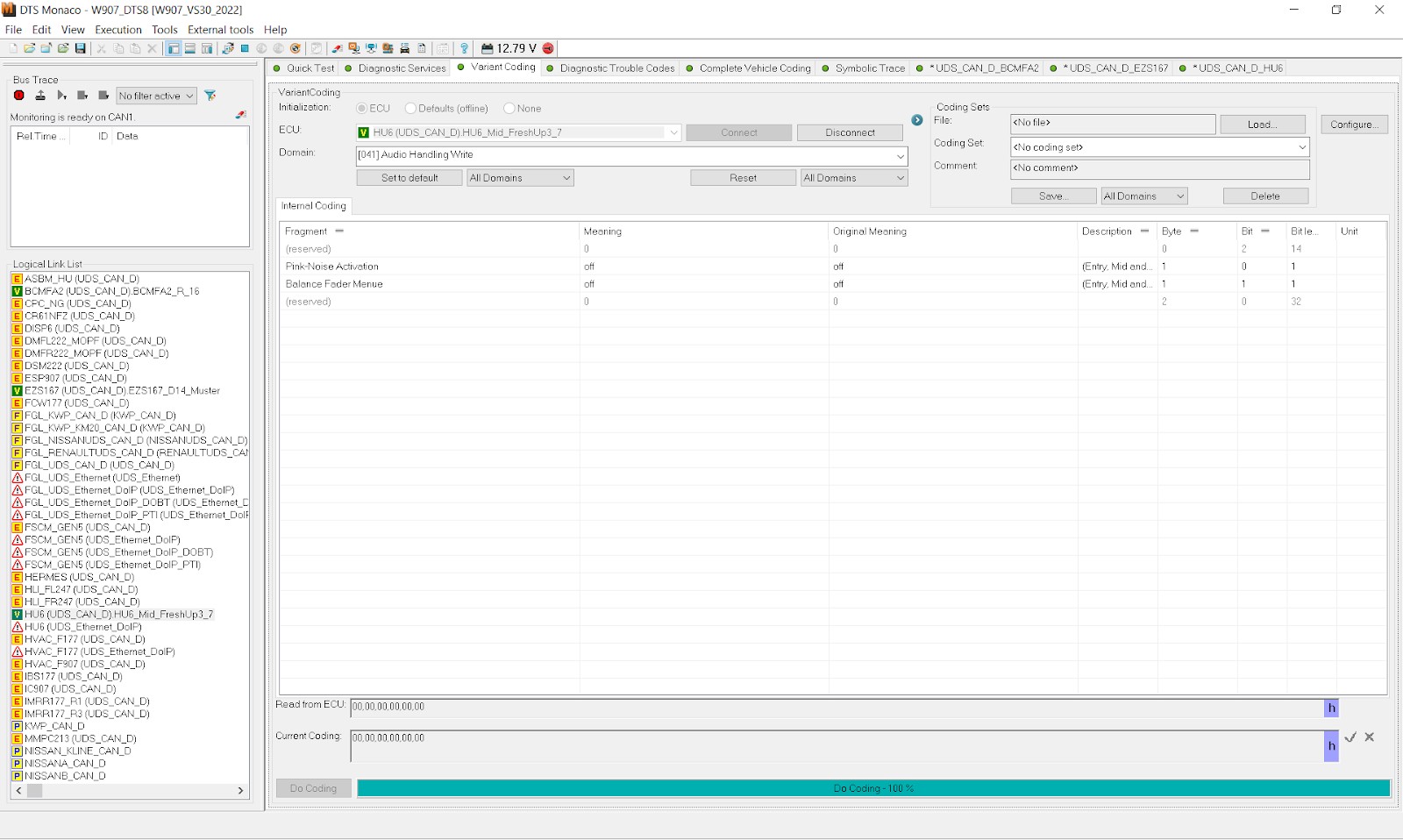 Do Coding Button
Do Coding Button
Step 6: Make Coding Changes Permanent
- Go back to the open tab with the ECU you just modified.
- In “Diagnostic Services,” find and transmit “[31] Synchronize to Non-volatile Memory Start,” followed by “[31] Synchronize to Non-volatile Memory Results.”
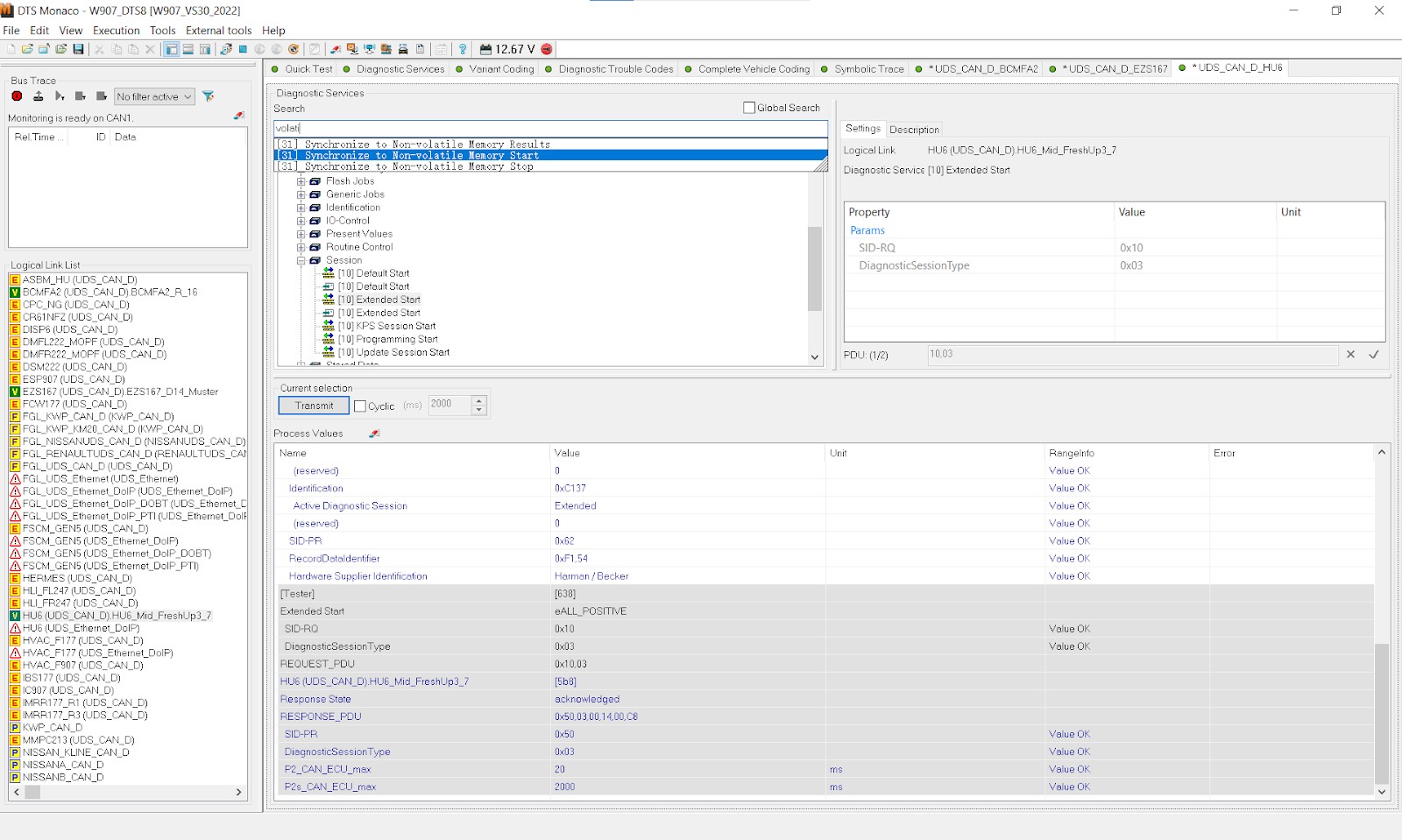 Synchronize to Non-Volatile Memory
Synchronize to Non-Volatile Memory
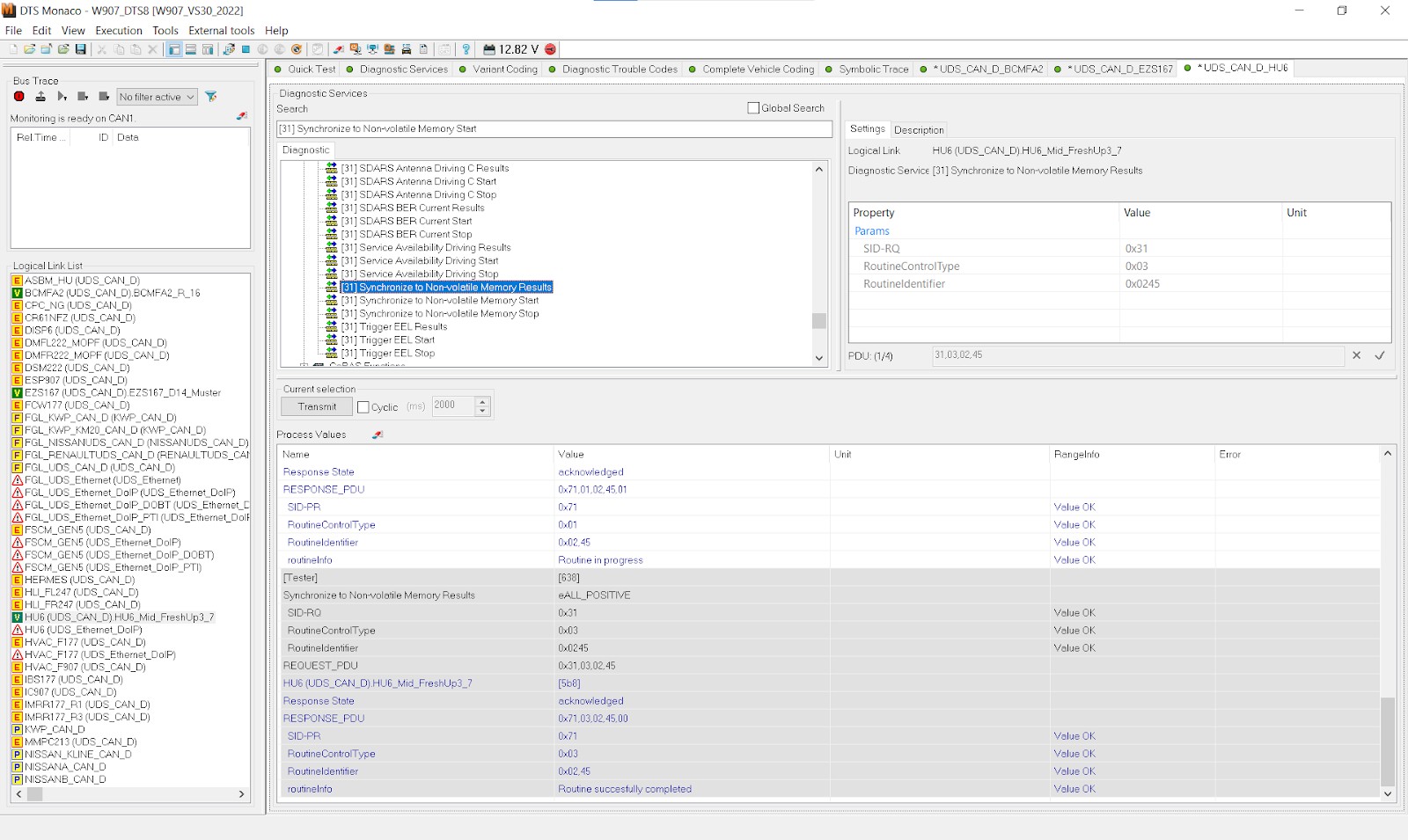 Non-Volatile Memory Results
Non-Volatile Memory Results - Perform a hard reset of the ECU by turning off the vehicle, opening the driver’s door, waiting a few minutes, and then turning the vehicle back on.
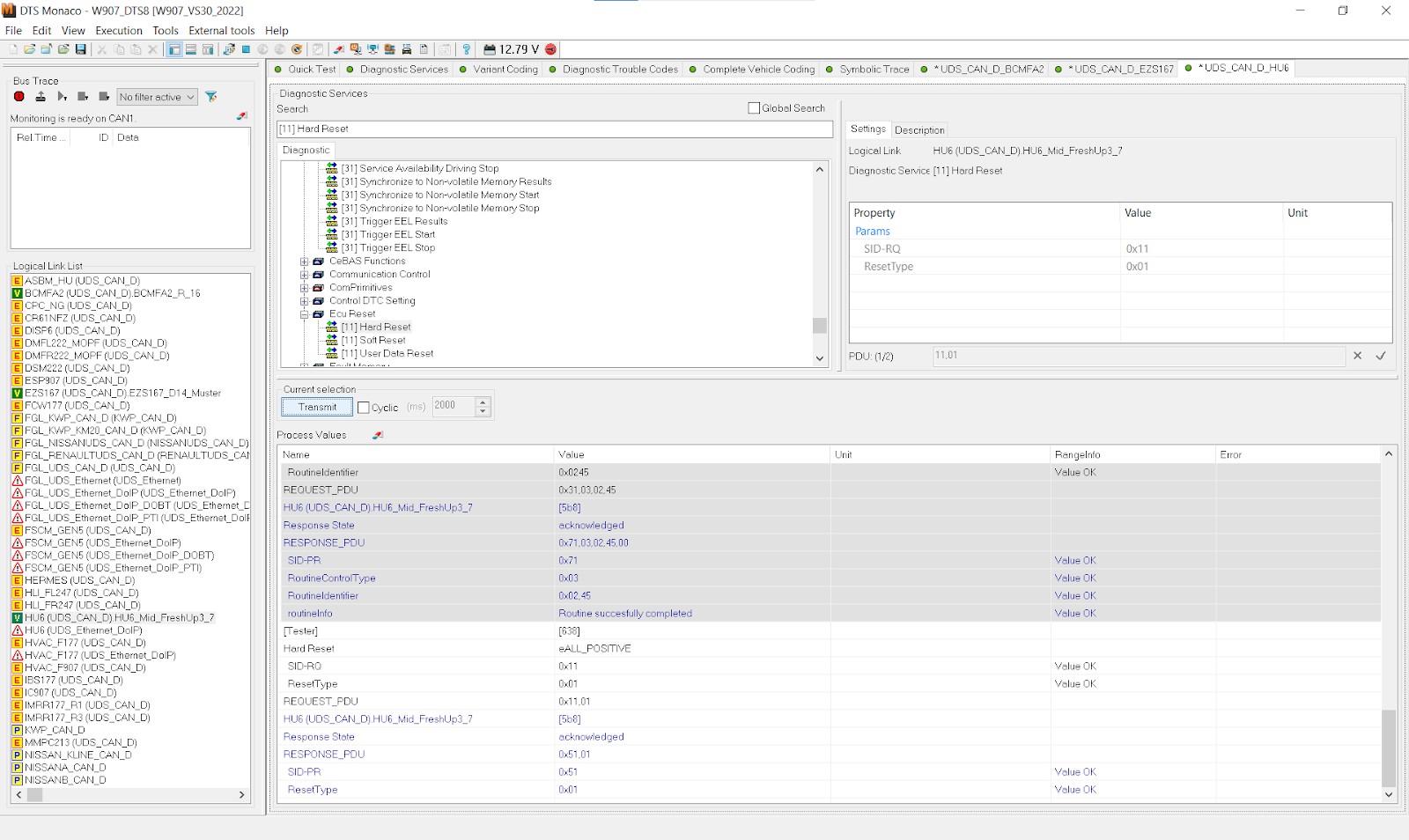 Hard Reset of ECU
Hard Reset of ECU
This step-by-step guide simplifies a basic database operation in DTS Monaco, demonstrating its straightforward and user-friendly approach. For more complex operations and advanced techniques, consider enrolling in our comprehensive training courses at DTS-MONACO.EDU.VN.
19. Can You Walk Me Through A Basic Database Operation Using Vediamo?
Delving into Vediamo: Here’s a basic database operation walkthrough, highlighting its intricate and customizable approach. Performing a basic database operation using Vediamo involves several complex steps:
Step 1: Connect to the Vehicle
- Launch Vediamo and create a new workspace or open an existing one.
- Connect your diagnostic interface to the vehicle’s OBD-II port and your computer.
- Configure the communication settings in Vediamo, including the correct communication protocol (e.g., CAN, K-Line) and baud rate.
Step 2: Select the ECU
- Manually select the ECU you want to work with from the list of available modules.
- Load the appropriate ECU description file (.cbf or .smr-d) for the selected module.
Step 3: Establish a Diagnostic Session
- Create a new diagnostic session by selecting the appropriate diagnostic service (e.g., “Read Data by Identifier”).
- Enter the data identifier (DID) for the parameter you want to read.
Step 4: Read ECU Data
- Transmit the diagnostic request to the ECU.
- Interpret the response data, which is typically presented in hexadecimal format.
- Use a data conversion tool or manual calculation to convert the hexadecimal data into a human-readable format.
Step 5: Modify ECU Data (Advanced)
- Create a new diagnostic session for writing data to the ECU (e.g., “Write Data by Identifier”).
- Enter the data identifier (DID) for the parameter you want to modify.
- Enter the new value in hexadecimal format.
- Transmit the diagnostic request to the ECU.
- Verify that the data has been successfully written by reading the parameter again and comparing the values.
Step 6: Save Changes
- Save the changes to a new ECU description file or create a backup of the original file.
- Perform a hard reset of the ECU by disconnecting the battery or using a diagnostic command.
This process highlights the complexity of Vediamo, emphasizing the need for advanced technical skills and a deep understanding of automotive ECU systems.
20. What Are The Most Common Car Coding Tasks That Can Be Performed Using DTS Monaco?
Discover the wide array of car coding possibilities with DTS Monaco, from simple tweaks to advanced feature enhancements. Most common car coding tasks that can be performed using DTS Monaco:
- Activating Hidden Features: Enabling features that are present in the vehicle’s software but not activated by default (e.g., cornering lights, enhanced Bluetooth functionality).
- Customizing Vehicle Settings: Modifying vehicle settings such as lighting configurations, seatbelt reminders, and climate control parameters.
- Retrofitting Options: Enabling support for aftermarket components and accessories (e.g., installing a new navigation system or upgrading the sound system).
- Disabling Annoying Features: Disabling unwanted features such as the start-stop system or speed limiters.
- Adjusting Performance Parameters: Modifying engine and transmission parameters to improve performance or fuel efficiency.
- Adapting Control Units: Adapting replacement control units to the vehicle’s configuration.
- Reading and Clearing Diagnostic Trouble Codes (DTCs): Diagnosing and resolving vehicle issues by reading and clearing DTCs.
By mastering these car coding tasks with DTS Monaco, automotive technicians can provide a wider range of services and enhance customer satisfaction.
FAQ: Vediamo vs. DTS Monaco Database Management
Q1: Is DTS Monaco Easier To Learn Than Vediamo?
Yes, DTS Monaco is generally easier to learn due to its user-friendly interface and guided diagnostic procedures.
Q2: Can I Use Vediamo Databases With DTS Monaco?
While direct integration is limited, you can leverage Vediamo data in DTS Monaco by creating custom routines and scripts.
Q3: What Are The Security Risks Associated With Vediamo?
Vediamo poses higher security risks due to its direct access to ECU memory, potentially compromising vehicle systems if misused.
Q4: Do Vehicle Manufacturers Support Vediamo For Database Operations?
Generally, vehicle manufacturers do not provide direct support for Vediamo due to its complexity and potential for misuse.
Q5: What Kind Of Training Do I Need For DTS Monaco?
You’ll need basic automotive knowledge and DTS Monaco software training, with hands-on practice being essential.
Q6: What Kind Of Training Do I Need For Vediamo?
You’ll need in-depth knowledge of automotive ECUs, programming skills, and Vediamo-specific training.
Q7: How Often Are DTS Monaco Databases Updated?
DTS Monaco databases are updated frequently to include the latest vehicle models and diagnostic information.
Q8: What Are The Most Common Mistakes When Using DTS Monaco?
Common mistakes include ignoring error messages, using incorrect data, and skipping steps in guided procedures.
Q9: What Are The Most Common Mistakes When Using Vediamo?
Common mistakes include incorrect configuration, data corruption, and failing to create backups.
Q10: Where Can I Get High-Quality Training For DTS Monaco And Vediamo In The USA?
DTS-MONACO.EDU.VN provides comprehensive training courses and resources for mastering both platforms in the USA.
Unlock your full potential in automotive diagnostics and car coding with DTS-MONACO.EDU.VN. Our expert training, comprehensive resources, and cutting-edge software solutions will empower you to excel in the rapidly evolving automotive industry. Ready to take the next step? Contact us today at Address: 275 N Harrison St, Chandler, AZ 85225, United States, Whatsapp: +1 (641) 206-8880, or visit our website at DTS-MONACO.EDU.VN to learn more about our offerings and start your journey towards mastery. Don’t miss out on the opportunity to enhance your skills, expand your service offerings, and drive your career forward. Reach out now and let us help you achieve your goals!
